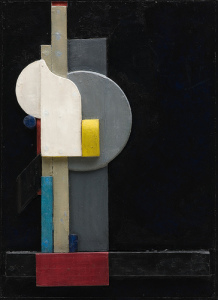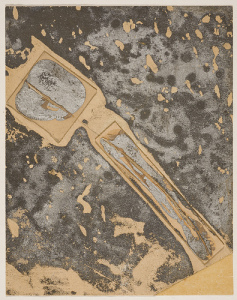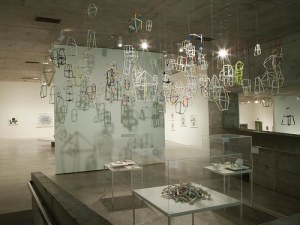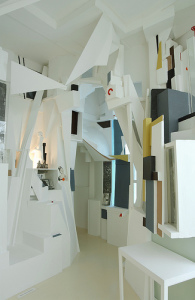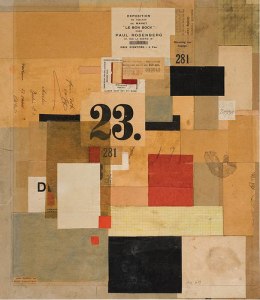
Kurt Schwitters: Mz 601, 1923; paint and paper on cardboard; 17 × 15 in.; Sprengel Museum, Hannover, loan from Kurt and Ernst Schwitters Stiftung. © 2011 Artists Rights Society (ARS), New York / VG Bild-Kunst, Bonn.
My favorite art shows remind me of an open mind, a mind that is, at least for a time, not distracted by finances, traffic, children, and what author Walker Percy called “everydayness.” A mind apart, completely focused on expression, on arranging or rearranging a small part of the universe. Some might call it a child’s mind. It is the purity of childhood combined with a lifetime of seeing.
The other night, I went to an opening at Creative Growth, an art center for the developmentally disabled a few blocks from our home in Oakland. Architect Anne Fougeron has guest curated a show called “Opposition/Composition.” Most of the pieces had an architectural angle, but only as an organizing principle. Most of the pieces felt fresh, the result of an open mind at work.
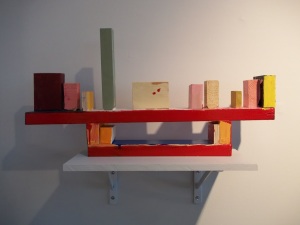 |
| Artist: Natascha Haehlen Sculpture at the Opposition/Composition show at Creative Growth curated by Anne Fougeron |
Over the weekend, I went to see the Kurt Schwitters show at the Berkeley Art Museum and found that there was a concurrent show, “Create,” with art from Creative Growth and two other similar art centers, Creativity Explored in San Francisco and the NIAD Art Center in Richmond. Mounting both shows simultaneously makes this small museum exciting. On the one hand, “Create” explicitly shows what are often referred to as outsider artists. Schwitters is now part of the canon, but he was also an outsider for most his life.
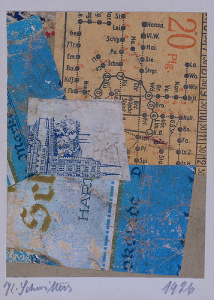 |
|
Kurt Schwitters: Untitled (okolade), 1926;
collage of cut printed, and marbleized papers on paperboard; image: 3 7/8 x 2 7/8 in.; the Menil Collection, Houston. Photo: Janet Woodard, Houston. |
Although the structure of the Berkeley Art Museum has been compromised by necessary seismic interventions, it remains one of my favorite modern buildings in the Bay Area. It opened as I entered middle school, and I visited a number of times throughout the 1970s. The whole family took a rare outing together to see the Claes Oldenburg show in 1971, which opened my eyes to what modern art might be. (Melting electric plugs!) For several years, a few of us from high school made almost weekly trips to see the baffling Hans Hoffman canvases on the top floor. The gentle ascent on ramps between galleries allows the viewer to slow down, focus on art, and then reconnect with the shared space occupied by other viewers. You can also take the elevator to the top and work your way down. This is a perfect way to move between the Schwitters show and the “Create” artists to see if they create a dialog. Both shows are both up for a few more weeks.
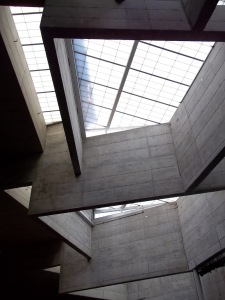 |
| Berkeley Art Museum |
Schwitters lived from 1887 to 1948. He enjoyed some recognition and success in his career in Germany in the era following World War I. However, after Hitler’s rise to power in 1933, Schwitters was ostracized and shown only in exhibitions of deviant art. Eventually he moved to Norway and later England, but was unable to rebuild his famous three-dimensional Merzbau or coalesce a movement around his ideas.
The artists participating in “Create” are mostly working at the beginning of this century and are considered outsiders because of their disabilities. Despite the decades separating Schwitters and these local artists, there are many commonalities. In some pieces, it is the juxtaposition of found objects or the surprising combinations of color and words or letters; in others, it is the apparent randomness that results in a balance just short of chaos. But all of the pieces show the unconscious at work. That moment when deliberation or intent gives way to pure action, pure joy—that moment when time is lost. I think this is what art philanthropist Dominique de Menil was after in her many curatorial projects. A hint of the divine. No surprise that the Schwitters show was organized by the Menil Collection.
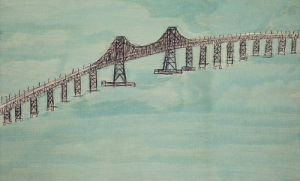 |
|
Lance Rivers: Richmond San Rafael Bridge, 2010;
ink and ballpoint pen on wood; 8 5/16 x 14 1/2 in.; courtesy of the artist and Creativity Explored, San Francisco. |
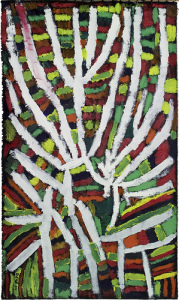 |
|
Mary Belknap: Untitled, 2006;
acrylic on fabric; 27 3⁄4 × 16 1⁄2 in.; courtesy of the artist and Creativity Explored, San Francisco. |
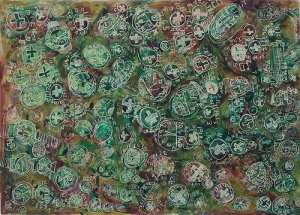 |
|
James Montgomery: Untitled, 2007;
correction fluid pen, ink, and acrylic on paper; 22 × 29 1⁄2 in.; courtesy of Creativity Explored, San Francisco. |
Rarely do two shows speak to each other this well about unconscious motivations without trying to make literal connections. While it may be unlikely that many of the artists in “Create” know about Schwitters, they evidence a similar desire to make order.
In the lowest gallery is the most ambitious aspect of the Schwitters show, a rebuilding of his much loved (and forever lost) Merzbau, a three-dimensional collage environment that existed in Schwitters’ Hanover flat. (It was destroyed by Allied bombers in 1943.) It has been reconstructed from historic photographs. Not every piece is there, but the essence of the room envelops a few people at a time and transports them. Wandering through the space, I kept thinking this space was timeless. All of the artists are part of one great all-encompassing art mind.
For more information:
http://en.wikipedia.org/wiki/Kurt_Schwitters
www.menil.org
www.creativityexplored.org
www.creativegrowth.org
http://niadart.org/
http://www.bampfa.berkeley.edu/
